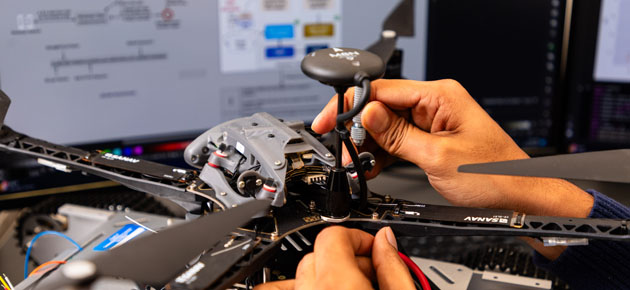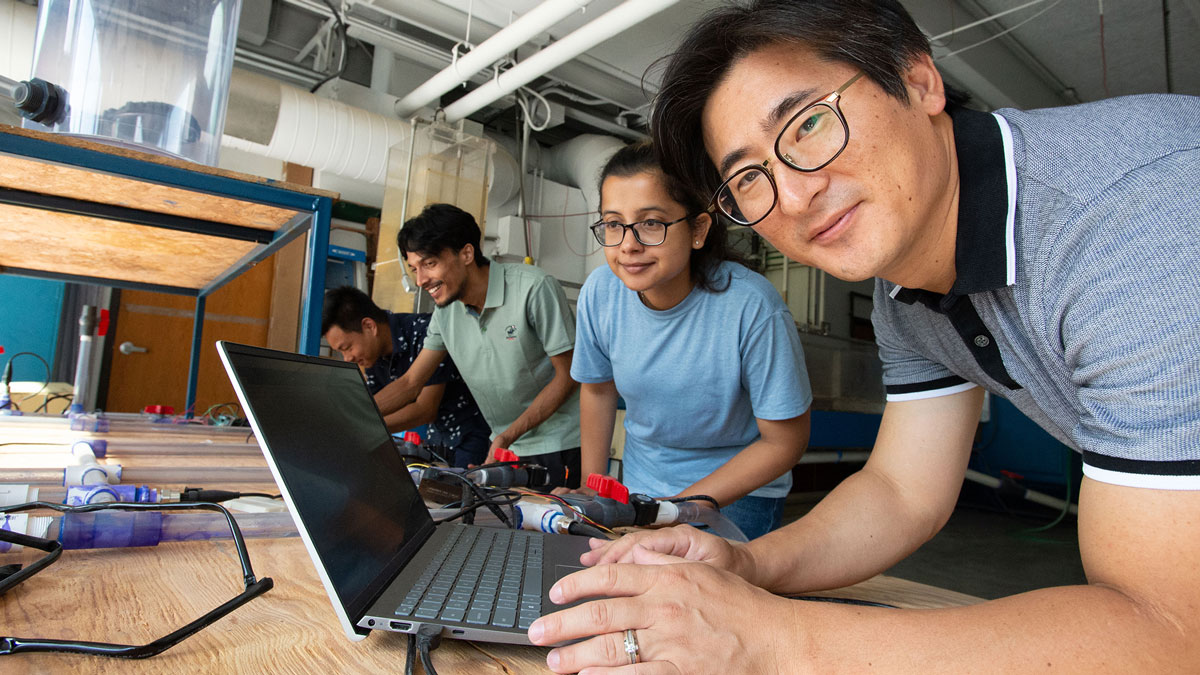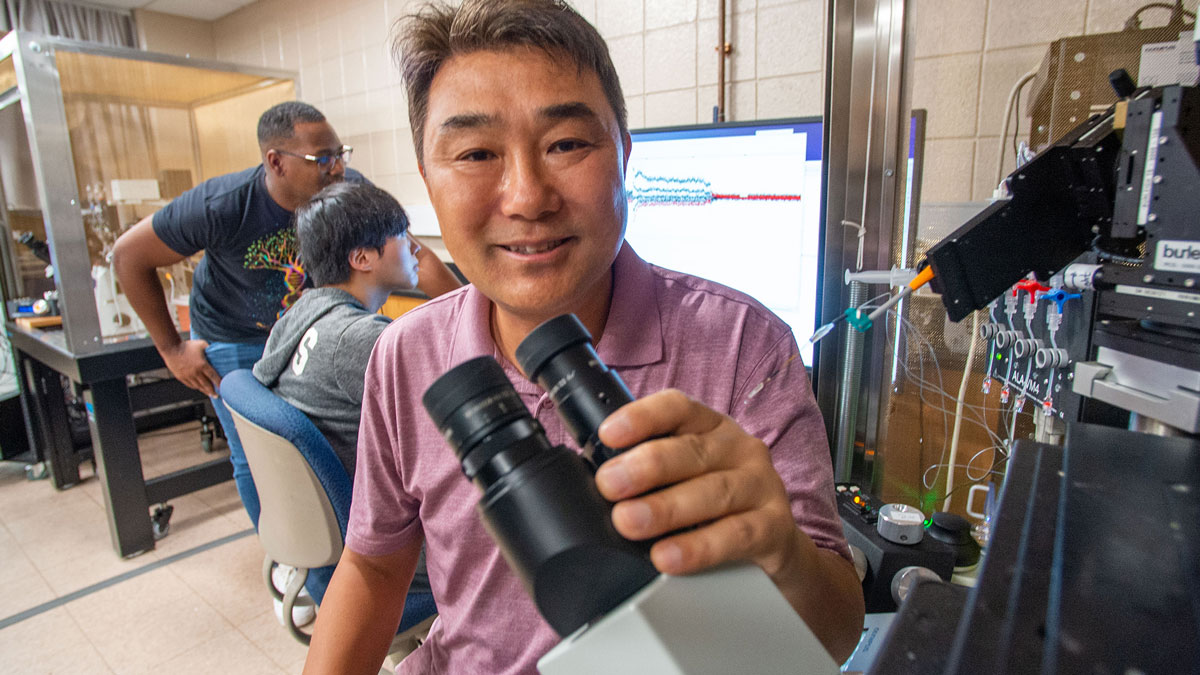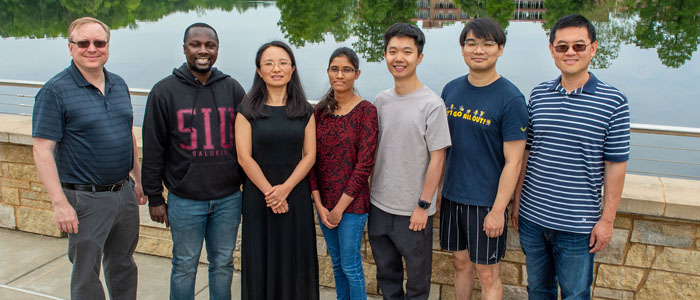Fall 2023 Newsletter
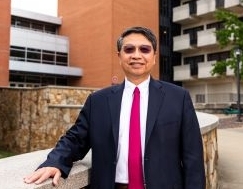 From the Dean: Our Progress Lays a Strong Foundation for the Future
From the Dean: Our Progress Lays a Strong Foundation for the Future
Southern Illinois University Carbondale’s College of Engineering, Computing, Technology, and Mathematics brings together a public doctoral research university – and flagship of the Southern Illinois University System – with disciplines that are vital to the U.S. economy and its prosperity and offer exciting career opportunities.
Engineering and technology have been a part of Southern Illinois University since 1945. Our current college was formed by expanding the former College of Engineering with additional programs in computer science, information technology, mathematics and other programs from other colleges in a campuswide reorganization in 2021. Our college has six schools: School of Electrical and Biomedical Engineering; Schoaol of Mechanical, Aerospace, and Materials Engineering; School of Computing; School of Civil, Environmental, and Infrastructure Engineering; School of Mathematical and Statistical Sciences, and School of Applied Engineering and Technology.
We are proud to have 79 tenured/tenure-track faculty members, 24 non-tenure track teaching faculty members and many part-time faculty members. Our student population is 1,350, including 359 graduate students. We offer many high-quality academic programs, including 12 undergraduate degree programs, 11 master’s degree programs and 4 Ph.D. programs in engineering, technology, computer science and mathematics. Many of these programs have had solid rankings in the category of national universities with Ph.D. programs by the U.S. News & World Report.
Our focus is on student success. Our student/faculty ratio is very low, sizes of classes are small and students receive personal attention from instructors. Our living learning community (LLC) creates a supportive environment for students both academically and socially. Graduates from our college are well received by employers, and our career placement rate is high.
You may be familiar with the university’s overall enrollment growth for the first time since 2014. Enrollment of the College of Engineering, Computing, Technology, and Mathematics increased by 6.2% in fall 2023, the highest annual growth rate among all the colleges of our university with more than 300 students. Based on enrollments of all programs at our college before and after reorganization, our college’s annual enrollment growth this year has been the highest for more than a decade. Specifically, the number of undergraduate freshmen increased by 8.4%, new undergraduate transfer students increased by 34% and new graduate students increased by 58%.
Faculty at the College of Engineering, Computing, Technology, and Mathematics are outstanding, with both a national and international reputation. They conduct state-of-art research and have won many research awards. Our college received new research grants of $3.54 million in the first ten months of 2023, including nine NSF grants. In addition to funded research, our faculty and students published many high-quality technical papers in top journals and conferences.
We also did well in our development. Our college is actively engaged with our alumni, and the college Industrial Advisory Board has its meetings three times a year. Our college raised funds of $1.92 million from donations in fiscal year 2023, representing a growth of 487% compared with 2020.
In summary, the College of Engineering, Computing, Technology, and Mathematics at SIU Carbondale made excellent progress in all areas of teaching, research, development and service. Especially, our college turned around its enrollment, grew its sponsored research programs and increased its funds of donations from alumni and supporters in the past three years. This has laid a solid foundation for more growth in the future.
Xiaoqing "Frank" Liu
Dean of College of Engineering, Computing, Technology, and Mathematics
Southern Illinois University Carbondale
[top]
Prof Gets $588K Grant to Shrink AI's Carbon Footprint
Iraklis Anagnostopoulos, an associate professor in the School of Electrical, Computer and Biomedical Engineering at SIU Carbondale, recently received a three-year, $588,000 grant from the National Science Foundation to study substantially improving the sustainability of modern edge data centers by mitigating the environmental impact of AI and boosting the efficiency of data processing. (Photo by Russell Bailey)
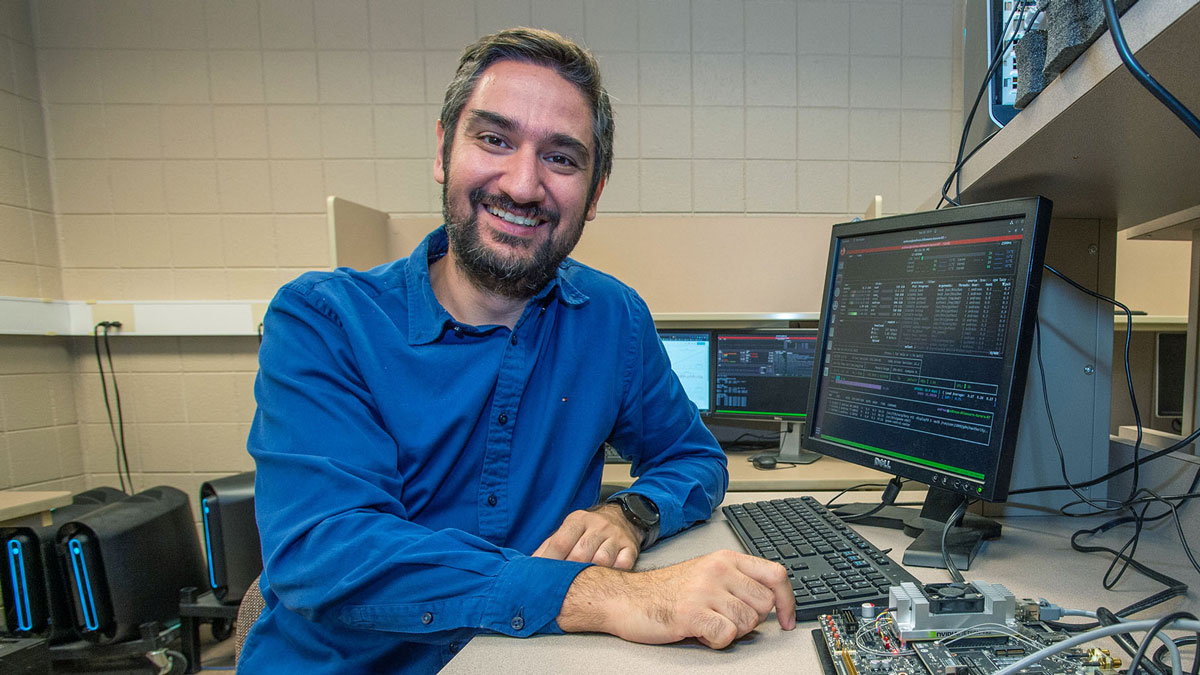
October 10, 2023
SIU prof gets $588K grant to shrink AI’s carbon footprint
CARBONDALE, Ill. – Big data and big AI need big power to operate. That’s why a researcher at Southern Illinois University Carbondale is studying ways to make this growing tech sector greener.
Iraklis Anagnostopoulos, an associate professor in the School of Electrical, Computer and Biomedical Engineering, recently received a three-year, $588,000 grant from the National Science Foundation to study substantially improving the sustainability of modern edge data centers by mitigating the environmental impact of AI and boosting the efficiency of data processing.
The AI market is anticipated to expand tenfold into a sector worth hundreds of billions of dollars within the next five years, Anagnostopoulos said. But the rapid expansion of this type of technology has caused apprehension about its impact on climate change.
“AI has enormous potential to positively influence society, and it’s projected to grow considerably in the coming years,” he said. “But along with this rapid expansion of AI technologies are issues with a considerable environmental impact and raised concerns about their associated operational and embodied carbon footprints. The former is associated with their ongoing operation and maintenance while the latter with the entire life cycle of the devices.”
Big power
AI, big data and the massive server farms that power them use a lot of electricity.
“The primary concern here is the energy required for the computation and data processing tasks,” Anagnostopoulos said. “These operations are usually carried out in large data centers that consume enormous amounts of electricity.”
Beyond simply powering the servers, operators must expend significant energy to cool the data centers, which necessarily create heat. The server environment must maintain a certain temperature to ensure they function optimally.
Network infrastructure that operates cloud-based storage and real-time data analytics also contributes to the growing carbon footprint in this sector, Anagnostopoulos said.
“The central aim of our research is to improve the sustainability by using extensive, multilayered optimizations of edge data centers,” he said. “Unlike conventional data centers, edge data centers are designed to be closer to end-users and able to harness renewable energy for their operations.”
Taking a high-tech approach
Optimization of edge data centers would enable a more localized computing infrastructure, Anagnostopoulos said. His research would move beyond traditional optimization methods and target “vertical solutions” for specific sectors of the infrastructure to improve the efficiency at each stage.
“There are multiple parameters that affect operational and embodied carbon footprints,” he said. “We’re trying to find ways of lessening the operational carbon footprint by harnessing renewable energy sources, enhancing power usage efficiency and strategically distributing workload across various computing components.”
At the same time, other ways to decrease the carbon footprint include down-scaling energy-efficient hardware accelerators, which are specialized units designed to perform specific functions more efficiently than a general-purpose central processing unit. Tensor processing units, a subcategory of these, are designed to accelerate machine learning calculations and are critical in speeding up computationally intensive tasks and making data processing more efficient.
“Developing reliable hardware accelerators and efficiently utilizing computing resources lead to more energy-efficient data centers,” Anagnostopoulos said. “It reduces the carbon footprint and improves their overall sustainability.”
Downscaling hardware accelerators would help reduce carbon in several ways.
First, smaller hardware accelerators often are designed to be more energy-efficient, using less power per computation. They also typically require fewer materials to manufacture, decreasing the rare-earth materials often needed in semiconductor manufacturing. Such efficiently designed hardware is often more reliable and has a longer lifespan, as well.
“Striking a balance between performance and the need for downscaling hardware is a difficult challenge,” Anagnostopoulos said. “The goal is to optimize hardware designs in a way that minimizes environmental impact without compromising the performance requirements essential for specific tasks.”
Anagnostopoulos hopes the work ultimately will promote the adoption of sustainable practices in the computing industry as a whole.
“We want to contribute to a broader paradigm shift toward embracing eco-friendly practices in the computing domain that will drive digital infrastructure’s transition towards a greener and more sustainable future,” he said.
[top]
Researcher Seeks to Stabilize Complex, Uncertain Water Supply Systems
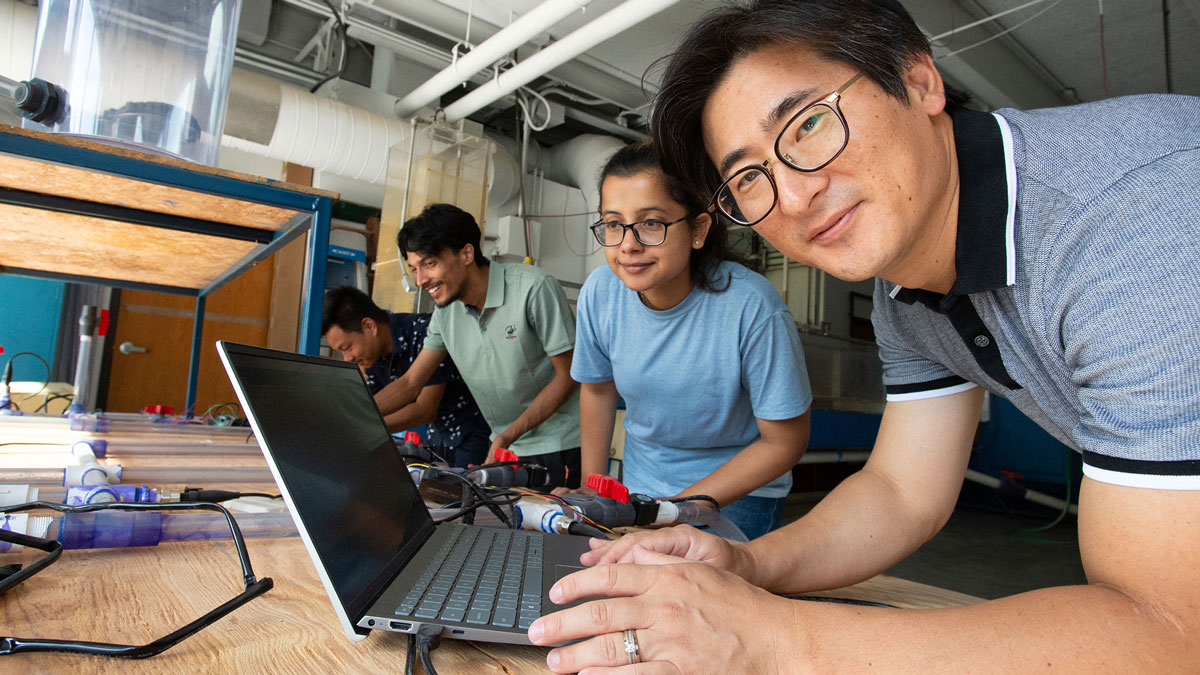
Sangmin Shin, right, assistant professor in the School of Civil, Environmental and Infrastructure Engineering, works with students in his laboratory. Shin recently received a $200,000 Engineering Research Initiation grant from the National Science Foundation to create new design focusing on establishing a water microgrid system — a network of networks melding centralized and decentralized water supply systems. (Photo by Russell Bailey)
September 14, 2023
SIU researcher seeks to stabilize complex, uncertain water supply systems
CARBONDALE, Ill. – Everyone knows that sinking feeling when you turn on the faucet and nothing comes out. A Southern Illinois University Carbondale researcher’s work aims to provide a water system design to avoid such crises.
Sangmin Shin, assistant professor in the School of Civil, Environmental and Infrastructure Engineering, recently received a $200,000 Engineering Research Initiation grant from the National Science Foundation to create new design focusing on establishing a water microgrid system — a network of networks melding centralized and decentralized water supply systems.
“Water use is a basic human right,” Shin said. “The ultimate challenge for current water infrastructure is to transform these complex, uncertain circumstances to be more sustainable and resilient simultaneously.”
The water microgrid concept employs W. Ross Ashby’s Law of Requisite Variety, which states a system must have at least as many control mechanisms and varieties of control as the number of variables impacting the system. Ashby was a British cybernetician working in the 1950s who became interested in the phenomenon of homeostasis, or the stability of a system under various conditions.
Water sources from near and far
You don’t have to look hard to find examples of conditions that can lead to shaky water supplies. California and Texas residents recently experienced drought and water-use restrictions. Drought, floods, hurricanes, earthquakes and simple aging infrastructure breakdowns all can result in local water systems inadequacies or failure. Outside and emerging threats include energy shortages, terrorism, cyberattack and others.
Water microgrid systems feature decentralized supply systems that utilize local water sources, such as rainwater and reclaimed water. These alternative supplies are then “nested” within existing centralized systems that typically use water sources from farther away.
The system could increase water use efficiency and conservation through water recycling and rainwater harvesting. It also could change operations between centralized and decentralized water supply as needed, providing a bulwark against unexpected disruptions.
Advancing engineering
Shin and his students will use the grant to build a lab-scale physical model of a working microgrid system that can test various configurations and operations. They also will develop a framework for how to integrate a microgrid into an existing water system while evaluating the sustainability and resilience at various scales.
The team also will conduct education and outreach activities using a project website, publications, course development, international partnership and other programs for the public and K-12 students.
“We will also encourage the participation of underrepresented students in research activities,” Shin said.
[top]
Prof to Study Mechanisms of Inflammation, Which May Lead to New Therapies
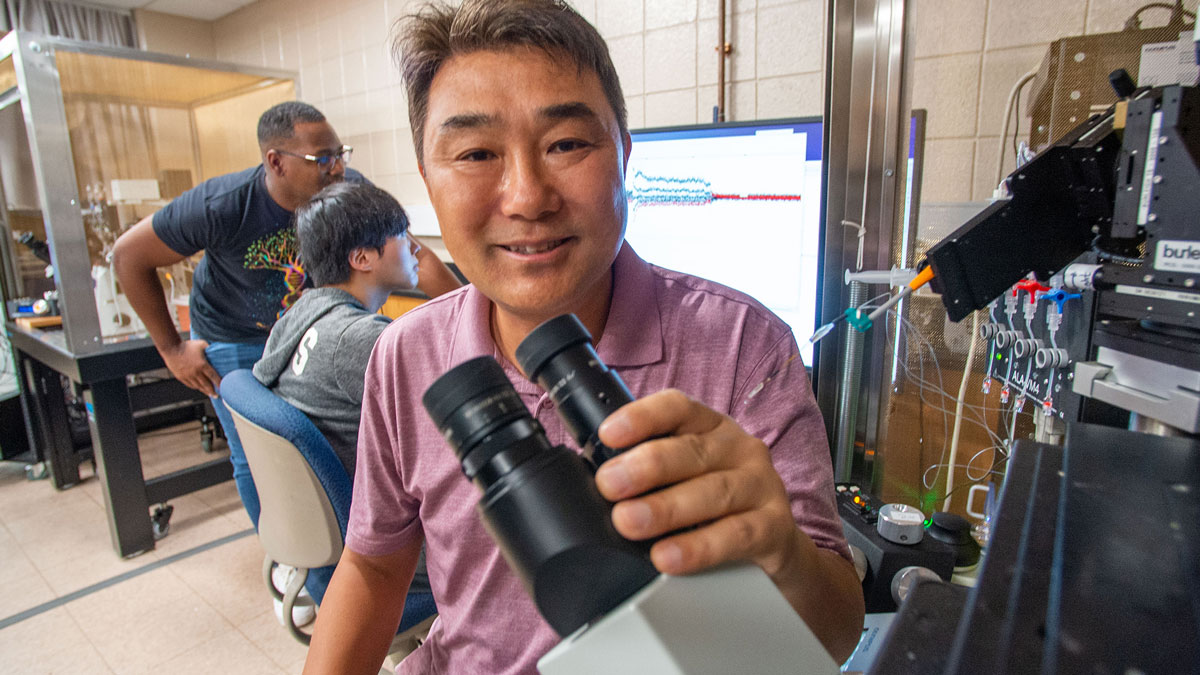
Chilman Bae, assistant professor in the School of Electrical, Computer, and Biomedical Engineering at SIU Carbondale, recently received a $200,000 Engineering Research Initiative grant from the National Science Foundation to look into mechanobiological ion channels, a subset of proteins that translate mechanical signals into biochemical responses in the body. (Photo by Russell Bailey)
October 04, 2023
SIU prof receives $200K to study mechanisms of inflammation, which may lead to new therapies
CARBONDALE, Ill. – A researcher at Southern Illinois University Carbondale is trying to find ways to better understand and control the inflammation process, an important biological dynamic in human health.
Chilman Bae, assistant professor in the School of Electrical, Computer, and Biomedical Engineering, recently received a $200,000 Engineering Research Initiative grant from the National Science Foundation to look into mechanobiological ion channels, a subset of proteins that translate mechanical signals into biochemical responses in the body. The two-year grant will cover salaries for Bae and two doctoral students, as well as essential laboratory supplies.
Bae said the project’s findings could offer potential therapeutic approaches to inflammation.
“We are trying to reveal the intricate mechanisms that control and regulate inflammation,” he said. “We aim to provide valuable insights.”
Inflammation’s impact
Medical science is highly interested in inflammation and the role it plays – both good and bad – in human health.
A natural response to injury, stress and illness, inflammation can play a vital role in healing and recovery. But it also can lead to discomfort – through processes such as swelling and fever – and overabundance of inflammation can lead to serious and chronic illness, impacting even nervous system senses such as hearing and touch.
Over-the-counter medicines such as naproxen and ibuprofen can provide relief from the unpleasant side effects of minor inflammation, but researchers have further turned their attention to chronic inflammation, studying pathways known as mechanosensitive ion channels and how changing them in response to a mechanical stimulus might impact that area.
Important pathways
Bae is focusing particularly on finding ways to safely chemically modulate the mechanosensitive ion channels called Piezo1 and Piezo2, which play key roles in touch, hearing and causing diseases. Such modulators, which include biochemicals that activate or inhibit reactions, might hold the key to preventing inflammation-related hearing loss, for example.
Some of the parts of the puzzle may lie in common foods, he said.
“Our objective is to find out if a fundamental amino acid prevalent in meat, fish and dairy can regulate the Piezo channel,” Bae said. “That channel potentially exerts a vital role in nervous system inflammation regulation.”
Scientists previously learned of an activator modulator known as Yoda1. But its toxicity makes it impossible to administer orally. Bae is investigating an innovative modulator that can overcome that issue.
“The challenge is to find selective modulators for these channels that are safe for human use,” Bae said. “Our project aims to identify and characterize this new Piezo1 modulator and then develop techniques for studying mechanosensitive channels.”
A key type of cell
Another aspect of the research involves creating an astrocyte cell model for inflammation in order to learn more about its underlying mechanism. Astrocytes not only regulate blood flow but also transfer mitochondria to neurons and supply the building blocks of neurotransmitters that in turn power neuronal metabolism and attack infections in nerve synapses.
“This work is aimed at providing a therapeutic framework for inflammation treatment and contributing to research and education in neuroscience, developmental biology and immunology,” Bae said.
Working in the laboratory, Bae and his students will examine the impact of modulators, looking at both the biophysical characteristics of Piezo1 and inflammation using in-vitro electrophysiological recordings, wound-healing experiments and calcium imaging.
[top]
Research Team Examines Treating Toxic Algae Blooms with Sunlight, Nanoparticles
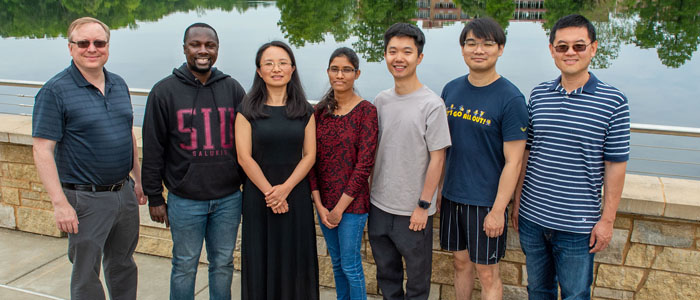
Members of an SIU team researching green ways to combat toxic algae blooms, from left, include Boyd M. Goodson, professor in the School of Chemical and Biomolecular Sciences; Joseph M. Kalinzi, research assistant; Jia Liu, team leader and associate professor in the School of Civil, Environmental and Infrastructure Engineering; Ishani M. Senanayake, research assistant; Haoran Yang, doctoral student in engineering science; Minxiao Wang, doctoral student in electrical and computer engineering; and Ruopu Li, associate professor in the School of Earth Systems and Sustainability. (Photo by Russell Bailey)
SIU researchers get $100,000 more to treat toxic algae blooms with sunlight, nanoparticles
By Tim Crosby
CARBONDALE, Ill. — A research team at Southern Illinois University Carbondale will continue its work on mitigating a common but toxic problem afflicting small bodies of water throughout the country, thanks to a new two-year $100,000 grant from the Environmental Protection Agency.
Jia Liu, associate professor in the School of Civil, Environmental and Infrastructure Engineering, is leading a crew of professors and students working on ways to eliminate toxic algae blooms by using solar power combined with iron-based nanomaterials to destroy its harmful effects. Her team’s research is focused on Campus Lake at SIU and Carbondale Reservoir, but the problem exists everywhere.
“If successful, our work will demonstrate an important, environmentally friendly way of dealing with a widespread issue,” Liu said.
Work on the project began in 2020, with an initial $25,000 proof-of-concept grant from the U.S. EPA’s People, Prosperity and the Planet Program, or P3. The most recent Phase II grant went to only five teams in the U.S.
Liu remains busy and involved with other research projects, as well. Recently she garnered a $500,000 grant from the National Science Foundation to research removal methods for per- and polyfluoroalkyl substances, better known as PFAS or forever chemicals. Such compounds have made life easier in many ways, from being key ingredients in firefighting foams and waterproof, breathable fabrics to food packaging and Teflon products. But scientists also have noted these substances stick around in the environment long after being used. This, among other factors, gives PFAS the potential to build up in the bodies of living organisms, where they might cause adverse effects.
Liu also is pursuing a project aimed at recovering rare-earth elements at the former sites of coal mining facilities, funded by a grant of almost $200,000 from the U.S. Department of the Interior.
Addressing toxic algae blooms
P3 is a unique competition open to teams of college and university students working to design solutions for a sustainable future. It aims to foster progress toward environmental awareness by achieving improved quality of life, economic prosperity and protection of the planet.
SIU’s solution to this problem, for instance, may be applied to other communities having similar issues involving occasional periods of rapid growth, or “blooms,” of the harmful blue-green algae known as cyanobacteria. It’s harmful to pets and wildlife, and human contact with the water affected by the blooms can cause skin rashes. Consequently, lakes afflicted with the condition should not be used for swimming and fishing, and SIU officials have restricted the use of Campus Lake at times during the last decade while the university searched for an environmentally responsible solution.
A new approach
Liu’s team’s concept aims to mitigate the harmful algal blooms during the early stages by reducing the amount of cyanobacteria, degrading cyanotoxins (which other methods don’t address) and removing phosphorus from the water.
Using samples from the lake, members use a gene-based method known as qPCR to determine the concentration of toxic cyanobacteria in a bloom. Researchers then employ magnetic photocatalysts, or iron-based nanoparticles, to mitigate the toxins.
Photocatalysis is a process by which light is used to accelerate a chemical reaction. In a previous project, Liu won a P3 grant to investigate using photoreactors and iron nanoparticles to remove a group of toxicants from water samples. In this current project, however, natural sunlight will serve as the light source for the chemical reaction.
Working in concert, the solar light and nanoparticles inactivate toxic cyanobacteria via physical attack and generated free radicals. They also break down toxins released by bacterial species and remove phosphates by adsorption, or the process by which a solid holds onto molecules of a gas or liquid as a thin film.
Because the nanoparticles are iron-based, they can easily be removed from the water using magnets, thus minimizing the addition of solid material to the lake sediments.
New money moves project forward
The new grant will help researchers deploy a more comprehensive approach to monitoring algae blooms using drones and automated, solar-powered water-sampling techniques. Combining these two methods could develop ways to predict such occurrences before they happen and improve response. It also will help researchers examine how water quality factors might impact the efficiency of the various mitigation techniques.
In addition, the new EPA grant will help researchers develop and manufacture a solar-powered floating, point-of-use system that will combine analysis and treatment for areas impacted by algae blooms. The team will deploy the system on Campus Lake for testing.
[top]
